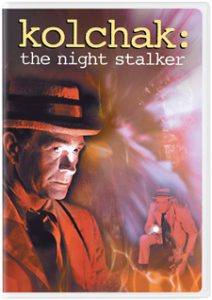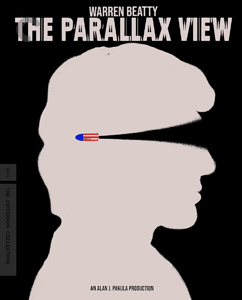Alan J. Pakula is arguably the most influential director in the second wave of noir in film history – Seventies neo-noir. The original wave dominated the Forties, and Pakula ushered that back with 1971’s “Klute,” basically the same type of story (a P.I. and a femme fatale search for a mysteriously missing man). It was “Seventies” only because it was set in the film’s present day.
But it’s with “The Parallax View” (1974) – and “Kolchak: The Night Stalker’s” (1972-75) parallel work on TV — that Seventies noir becomes defined as conspiracy noir. And thus these works influence the third wave, “The X-Files” and all its TV knockoffs, in which complex conspiracies (“mythologies”) would be expected by viewers.
Despite its 50 years of influence, it’s clear that something precisely like “The Parallax View” will never be made again, so it’s wonderful that we can rewatch it. Working from Loren Singer’s 1970 novel, writers David Giler (“Aliens,” “Alien 3”) and Lorenzo Semple Jr. craft a story that’s compelling because (MILD SPOILERS FOLLOW) we never find out precisely who the bad guys are or what their specific goals are.

“The Parallax View” (1974)
Director: Alan J. Pakula
Writers: David Giler, Lorenzo Semple Jr. (screenplay), Loren Singer (novel)
Stars: Warren Beatty, Paula Prentiss, William Daniels
Over three days, RFMC is looking back at the masterful and influential “paranoia trilogy” – “Klute” (1971), “The Parallax View” (1974) and “All the President’s Men” (1976).
“Parallax” gives me a new appreciation for what Chris Carter was trying to do on “The X-Files” – and an angle for apologetics. Part of why the “X-Files” mythology was a mess is that the mess was purposeful. We and Fox Mulder were never meant to figure out the string-pullers’ aims. That didn’t play well in a long-running series, but in a 100-minute movie, it is chilling. (END OF MILD SPOILERS.)
Warren Beatty is an effective lead as Joe Frady, a nobody Oregon reporter who wants to find out why a rising politician was assassinated in front of him and others at the Space Needle. The film has basically no other main characters – although certainly Hume Cronyn (as Frady’s editor) and others are excellent in supporting roles.
A grand empty stage
This helps give Pakula a sense of empty etherealness for Frady and his world. He will meet people but he’ll never fully grasp them. Even people on his side – his ex-girlfriend fellow reporter (Paula Prentiss), and the dead politician’s assistant (William Daniels) – can only do so much because they are targeted by the same mysterious puppet masters.

Adding to this vibrant emptiness is the way Pakula maximizes a modest budget. Most notable is a grand finale that contrasts with the parade opening. We follow another political riser, but instead of seeing the big speech in a sort of parking garage/sports arena (it’s hard to tell), we see the rehearsal for it. In the catwalks, Frady – who has infiltrated the Parallax company, which hires psychologically damaged people as assassins — pursues shadowy figures.
If more people were present, the bad guys could still pull it off, but the fact that they target the rehearsal emphasizes how their goals are successfully achieved when people aren’t looking – like a grand magic act. Frady knows nothing of magic, so he’s in over his head, even when he makes ingenious observations.
Pakula is a masterful filmmaker, sometimes borrowing from others (the focus on a suitcase bomb from baggage check to the plane’s luggage compartment is a Hitchcockian brand of suspense) but also regularly innovating.
In the finale, he gives a close-up of the politician, but for rehearsal purposes, they’re just playing a recording of his speech. The politician is merely smoking, giving mundane directions to his staff and ghost-practicing his golf swing. Most future conspiracy noirs would cater to viewers’ desire to know details about all the players, but not “Parallax.”
Bring your own meaning
I suppose there’s room to graft on our own meaning. This was – in retrospect – a pivotal time in the decline of the American Empire. In 1971, the Nixon administration took the U.S. off the gold standard, making it possible for the 21st century situation where the value of our money drops when the Federal Reserve prints “new” dollars. The American Dream of working hard and climbing the ladder can be negated in back rooms.
So maybe “Parallax’s” shadow operators have something to do with pulling the strings of government decisions; the result for them is more money and more power to make more money. This is a safe guess, in fact. But because Pakula and his writers choose to not dig into the details, the point is much stronger, much scarier.
Today, viewers desire specific, mundane goals (perhaps one person wants to gain political office) in their conspiracy storytelling. At the end of the day, they want escapism, even in their grim stories. “Parallax” does not go in for that. It was a part of a short period of films so grim that it led George Lucas – himself a contributor to the trend with “THX-1138” (1971) – to see the opening for a crowd-pleaser (1977’s “Star Wars”) to make boffo money and change the next 50 years of Hollywood.
Pakula’s film is stuck in its time. But by skipping “the point,” it’s actually more on point than modern grim miniseries that end with the bad guy being caught. And even “The X-Files” (which occasionally pops up with new TV continuations) is stuck in an awkward middle because it at least shows us the smoke-filled back rooms (even though the conspirators’ conversations are about strategies for obfuscation).
By being intentionally vague in its plotting, “The Parallax View” previews the entire future of American history.
Typewriter image by Markus Winkler from Pixabay

